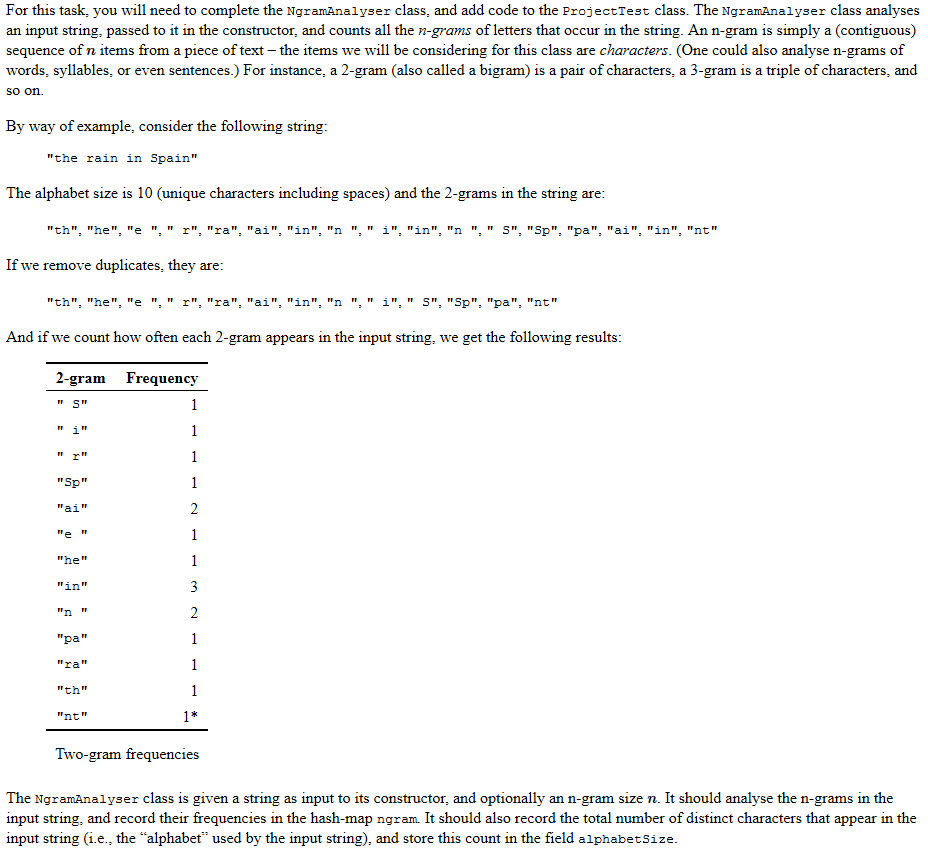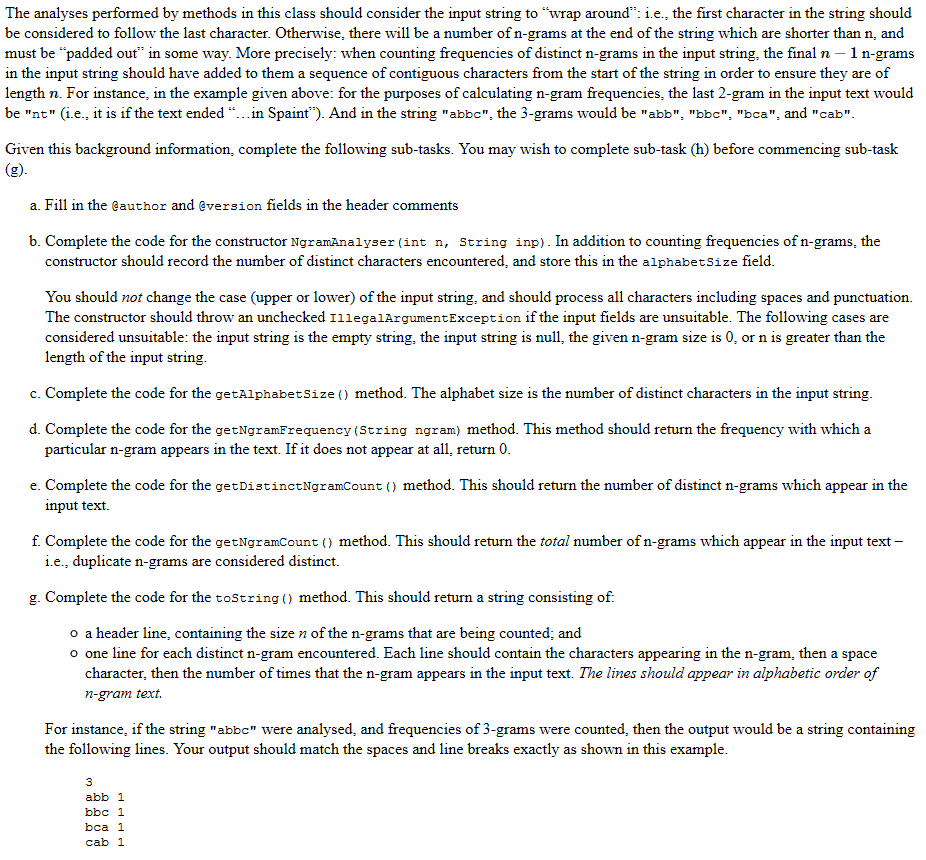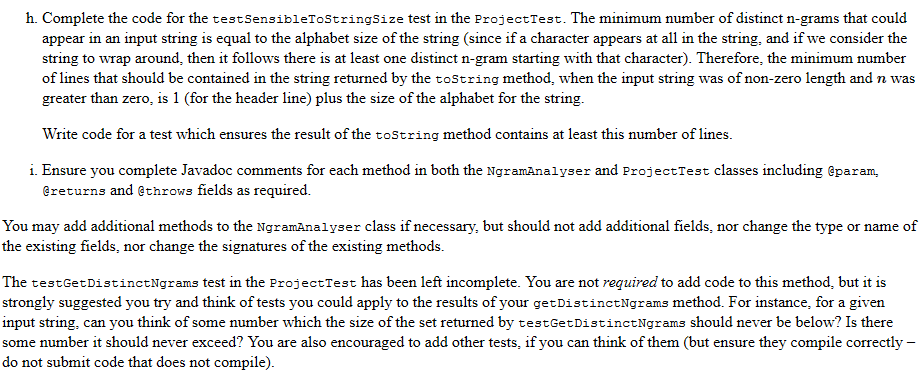Question
Analysing n-grams in a sample text (NgramAnalyser) > import java.util.ArrayList; import java.util.HashMap; import java.util.Set; import java.util.HashSet; import java.util.Arrays; /** * Perform n-gram analysis of a
Analysing n-grams in a sample text (NgramAnalyser)



>
import java.util.ArrayList; import java.util.HashMap; import java.util.Set;
import java.util.HashSet; import java.util.Arrays;
/** * Perform n-gram analysis of a string. * * Analyses the frequency with which distinct n-grams, of length n, * appear in an input string. For the purposes of all analyses of the input * string, the final n-1 n-grams appearing in the string should be * "filled out" to a length of n characters, by adding * a sequence of contiguous characters from the start of the string. * e.g. "abbc" includes "bca" and "cab" in its 3-grams * * @author * @version */ public class NgramAnalyser { /** dictionary of all distinct n-grams and their frequencies */ private HashMap
/** number of distinct characters in the input */ private int alphabetSize;
/** n-gram size for this object (new field) */ private int ngramSize;
/** * Analyse the frequency with which distinct n-grams, of length n, * appear in an input string. * n-grams at the end of the string wrap to the front * e.g. "abbbbc" includes "bca" and "cab" in its 3-grams * @param int n size of n-grams to create * @param String inp input string to be modelled */ public NgramAnalyser(int n, String inp) { //TODO replace this line with your code }
/** * Analyses the input text for n-grams of size 1. */ public NgramAnalyser(String inp) { this(1,inp); }
/** * @return int the size of the alphabet of a given input */ public int getAlphabetSize() { //TODO replace this line with your code return -1; }
/** * @return the total number of distinct n-grams appearing * in the input text. */ public int getDistinctNgramCount() { //TODO replace this line with your code return -1; }
/** * @return Return a set containing all the distinct n-grams * in the input string. */ public Set
/** * @return the total number of n-grams appearing * in the input text (not requiring them to be distinct) */ public int getNgramCount() { //TODO replace this line with your code return -1; }
/** Return the frequency with which a particular n-gram appears * in the text. If it does not appear at all, return 0. * * @param ngram The n-gram to get the frequency of * @return The frequency with which the n-gram appears. */ public int getNgramFrequency(String ngram) { //TODO replace this line with your code return -1; }
/** * Generate a summary of the ngrams for this object. * @return a string representation of the n-grams in the input text * comprising the ngram size and then each ngram and its frequency * where ngrams are presented in alphabetical order. */ public String toString() { //TODO replace this line with your code return null; }
}
--------------------------------------------------------------------------------------------------------------------------
--------------------------------------------------------------------------------------------------------------------------
>
import static org.junit.Assert.*; import org.junit.After; import org.junit.Before; import org.junit.Test;
/** * The test class ProjectTest for student test cases. * Add all new test cases to this task. * * @author * @version */ public class ProjectTest { /** * Default constructor for test class ProjectTest */ public ProjectTest() { }
/** * Sets up the test fixture. * * Called before every test case method. */ @Before public void setUp() { }
/** * Tears down the test fixture. * * Called after every test case method. */ @After public void tearDown() { } //TODO add new test cases from here include brief documentation @Test(timeout=1000) public void testSensibleToStringSize() { assertEquals(0,1); //TODO replace with test code }
@Test(timeout=1000) public void testGetDistinctNgrams() { assertEquals(0,1); //TODO replace with test code } }
For this task, you will need to complete the NgramAnalyser class, and add code to the ProjectTest class. The NgramAnalyser class analyses an input string, passed to it in the constructor, and counts all the n-grams of letters that occur in the string. An n-gram is simply a (contiguous sequence of n items from a piece of text the items we will be considering for this class are characters. (One could also analyse n-grams of words, syllables, or even sentences. For instance, a 2-gram (also called a bigram is a pair of characters, a 3-gram is a triple of characters, and So on. By way of example, consider the following string: the rain in Spain The alphabet size is 10 (unique characters including spaces) and the 2-grams in the string are: "th". "he''. "e r". "ra". "ai". "in''. ''n i "in". "n S "Sp", "pa". "ai". "in". "nt" If we remove duplicates, they are "th", "he", "e r", "ra". "ai", "in", "n i". S". "Sp "pa", "nt'' And if we count how often each 2-gram appears in the input string, we get the following results gram Frequency Sp al ln "pa" ra. nt Two gram frequencies The NgramAnalyser class is given a string as input to its constructor, and optionally an n-gram size n. It should analyse the n-grams in the input string, and record their frequencies in the hash-map ngram. It should also record the total number of distinct characters that appear in the input string (i.e., the "alphabet" used by the input string), and store this count in the field alphabetsizeStep by Step Solution
There are 3 Steps involved in it
Step: 1

Get Instant Access to Expert-Tailored Solutions
See step-by-step solutions with expert insights and AI powered tools for academic success
Step: 2

Step: 3

Ace Your Homework with AI
Get the answers you need in no time with our AI-driven, step-by-step assistance
Get Started


